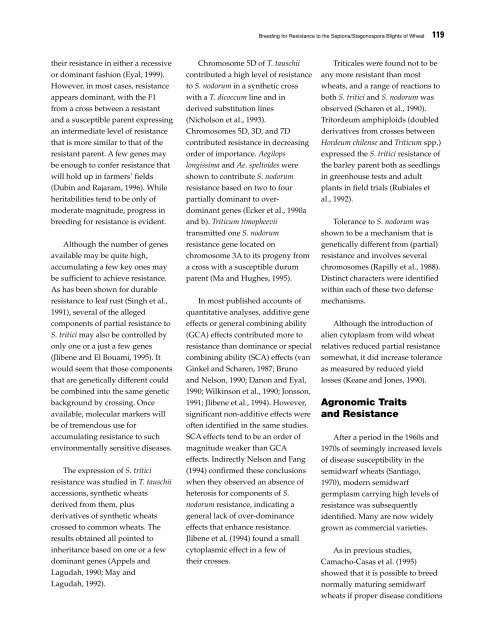Septoria and Stagonospora Diseases of Cereals - CIMMYT ...
Septoria and Stagonospora Diseases of Cereals - CIMMYT ...
Septoria and Stagonospora Diseases of Cereals - CIMMYT ...
Create successful ePaper yourself
Turn your PDF publications into a flip-book with our unique Google optimized e-Paper software.
their resistance in either a recessive<br />
or dominant fashion (Eyal, 1999).<br />
However, in most cases, resistance<br />
appears dominant, with the F1<br />
from a cross between a resistant<br />
<strong>and</strong> a susceptible parent expressing<br />
an intermediate level <strong>of</strong> resistance<br />
that is more similar to that <strong>of</strong> the<br />
resistant parent. A few genes may<br />
be enough to confer resistance that<br />
will hold up in farmers’ fields<br />
(Dubin <strong>and</strong> Rajaram, 1996). While<br />
heritabilities tend to be only <strong>of</strong><br />
moderate magnitude, progress in<br />
breeding for resistance is evident.<br />
Although the number <strong>of</strong> genes<br />
available may be quite high,<br />
accumulating a few key ones may<br />
be sufficient to achieve resistance.<br />
As has been shown for durable<br />
resistance to leaf rust (Singh et al.,<br />
1991), several <strong>of</strong> the alleged<br />
components <strong>of</strong> partial resistance to<br />
S. tritici may also be controlled by<br />
only one or a just a few genes<br />
(Jlibene <strong>and</strong> El Bouami, 1995). It<br />
would seem that those components<br />
that are genetically different could<br />
be combined into the same genetic<br />
background by crossing. Once<br />
available, molecular markers will<br />
be <strong>of</strong> tremendous use for<br />
accumulating resistance to such<br />
environmentally sensitive diseases.<br />
The expression <strong>of</strong> S. tritici<br />
resistance was studied in T. tauschii<br />
accessions, synthetic wheats<br />
derived from them, plus<br />
derivatives <strong>of</strong> synthetic wheats<br />
crossed to common wheats. The<br />
results obtained all pointed to<br />
inheritance based on one or a few<br />
dominant genes (Appels <strong>and</strong><br />
Lagudah, 1990; May <strong>and</strong><br />
Lagudah, 1992).<br />
Chromosome 5D <strong>of</strong> T. tauschii<br />
contributed a high level <strong>of</strong> resistance<br />
to S. nodorum in a synthetic cross<br />
with a T. dicoccum line <strong>and</strong> in<br />
derived substitution lines<br />
(Nicholson et al., 1993).<br />
Chromosomes 5D, 3D, <strong>and</strong> 7D<br />
contributed resistance in decreasing<br />
order <strong>of</strong> importance. Aegilops<br />
longissima <strong>and</strong> Ae. speltoides were<br />
shown to contribute S. nodorum<br />
resistance based on two to four<br />
partially dominant to overdominant<br />
genes (Ecker et al., 1990a<br />
<strong>and</strong> b). Triticum timopheevii<br />
transmitted one S. nodorum<br />
resistance gene located on<br />
chromosome 3A to its progeny from<br />
a cross with a susceptible durum<br />
parent (Ma <strong>and</strong> Hughes, 1995).<br />
In most published accounts <strong>of</strong><br />
quantitative analyses, additive gene<br />
effects or general combining ability<br />
(GCA) effects contributed more to<br />
resistance than dominance or special<br />
combining ability (SCA) effects (van<br />
Ginkel <strong>and</strong> Scharen, 1987; Bruno<br />
<strong>and</strong> Nelson, 1990; Danon <strong>and</strong> Eyal,<br />
1990; Wilkinson et al., 1990; Jonsson,<br />
1991; Jlibene et al., 1994). However,<br />
significant non-additive effects were<br />
<strong>of</strong>ten identified in the same studies.<br />
SCA effects tend to be an order <strong>of</strong><br />
magnitude weaker than GCA<br />
effects. Indirectly Nelson <strong>and</strong> Fang<br />
(1994) confirmed these conclusions<br />
when they observed an absence <strong>of</strong><br />
heterosis for components <strong>of</strong> S.<br />
nodorum resistance, indicating a<br />
general lack <strong>of</strong> over-dominance<br />
effects that enhance resistance.<br />
Jlibene et al. (1994) found a small<br />
cytoplasmic effect in a few <strong>of</strong><br />
their crosses.<br />
Breeding for Resistance to the <strong>Septoria</strong>/<strong>Stagonospora</strong> Blights <strong>of</strong> Wheat 119<br />
Triticales were found not to be<br />
any more resistant than most<br />
wheats, <strong>and</strong> a range <strong>of</strong> reactions to<br />
both S. tritici <strong>and</strong> S. nodorum was<br />
observed (Scharen et al., 1990).<br />
Tritordeum amphiploids (doubled<br />
derivatives from crosses between<br />
Hordeum chilense <strong>and</strong> Triticum spp.)<br />
expressed the S. tritici resistance <strong>of</strong><br />
the barley parent both as seedlings<br />
in greenhouse tests <strong>and</strong> adult<br />
plants in field trials (Rubiales et<br />
al., 1992).<br />
Tolerance to S. nodorum was<br />
shown to be a mechanism that is<br />
genetically different from (partial)<br />
resistance <strong>and</strong> involves several<br />
chromosomes (Rapilly et al., 1988).<br />
Distinct characters were identified<br />
within each <strong>of</strong> these two defense<br />
mechanisms.<br />
Although the introduction <strong>of</strong><br />
alien cytoplasm from wild wheat<br />
relatives reduced partial resistance<br />
somewhat, it did increase tolerance<br />
as measured by reduced yield<br />
losses (Keane <strong>and</strong> Jones, 1990).<br />
Agronomic Traits<br />
<strong>and</strong> Resistance<br />
After a period in the 1960s <strong>and</strong><br />
1970s <strong>of</strong> seemingly increased levels<br />
<strong>of</strong> disease susceptibility in the<br />
semidwarf wheats (Santiago,<br />
1970), modern semidwarf<br />
germplasm carrying high levels <strong>of</strong><br />
resistance was subsequently<br />
identified. Many are now widely<br />
grown as commercial varieties.<br />
As in previous studies,<br />
Camacho-Casas et al. (1995)<br />
showed that it is possible to breed<br />
normally maturing semidwarf<br />
wheats if proper disease conditions









